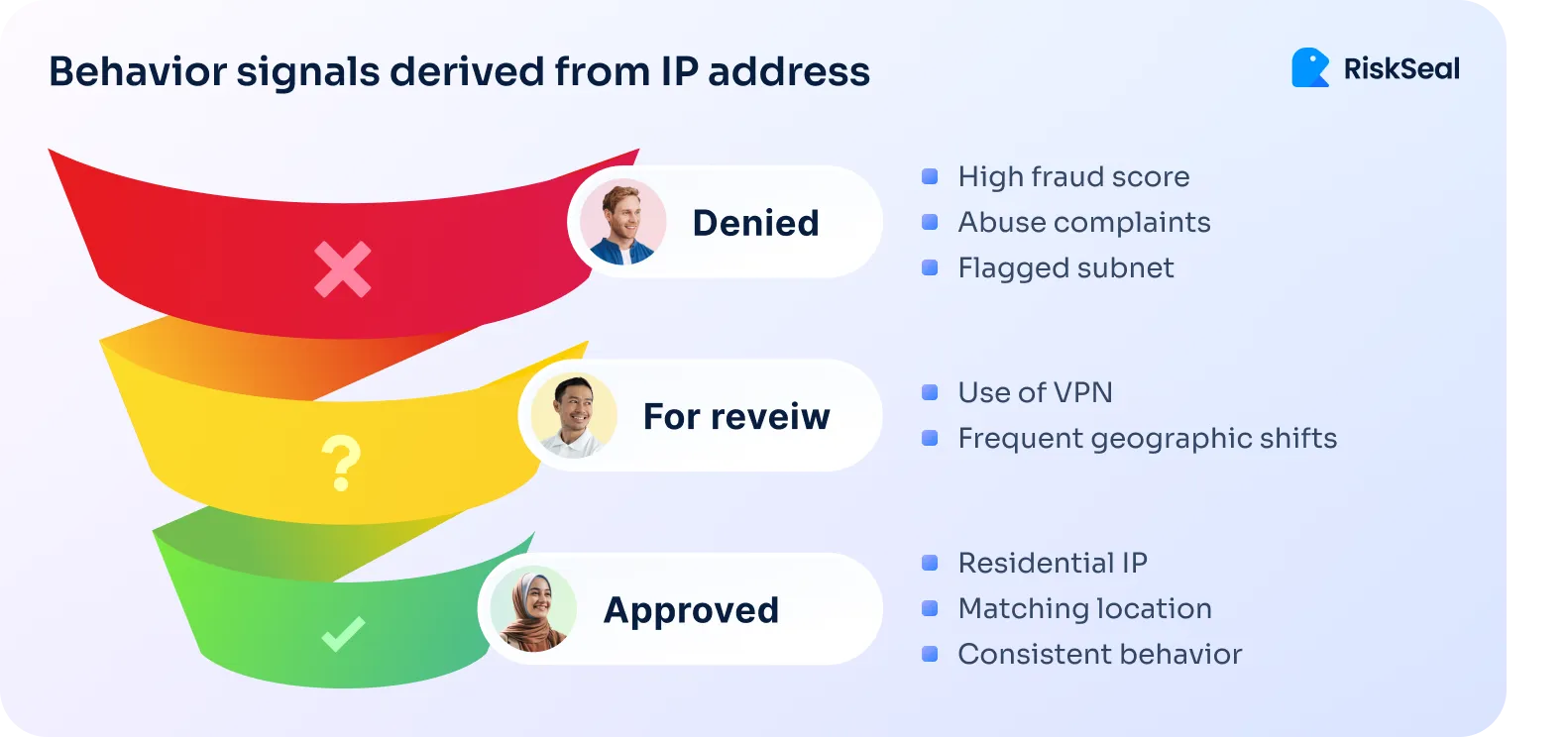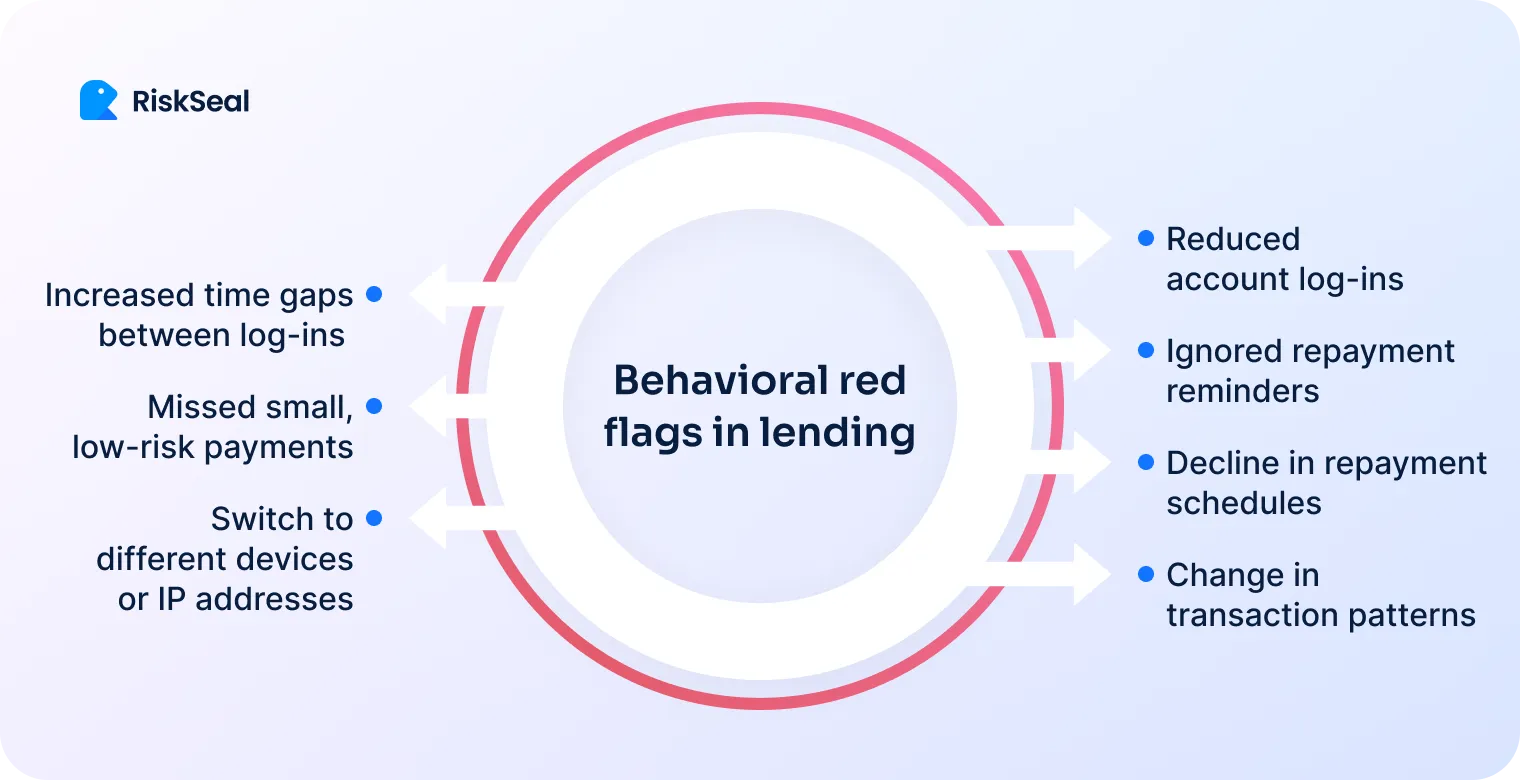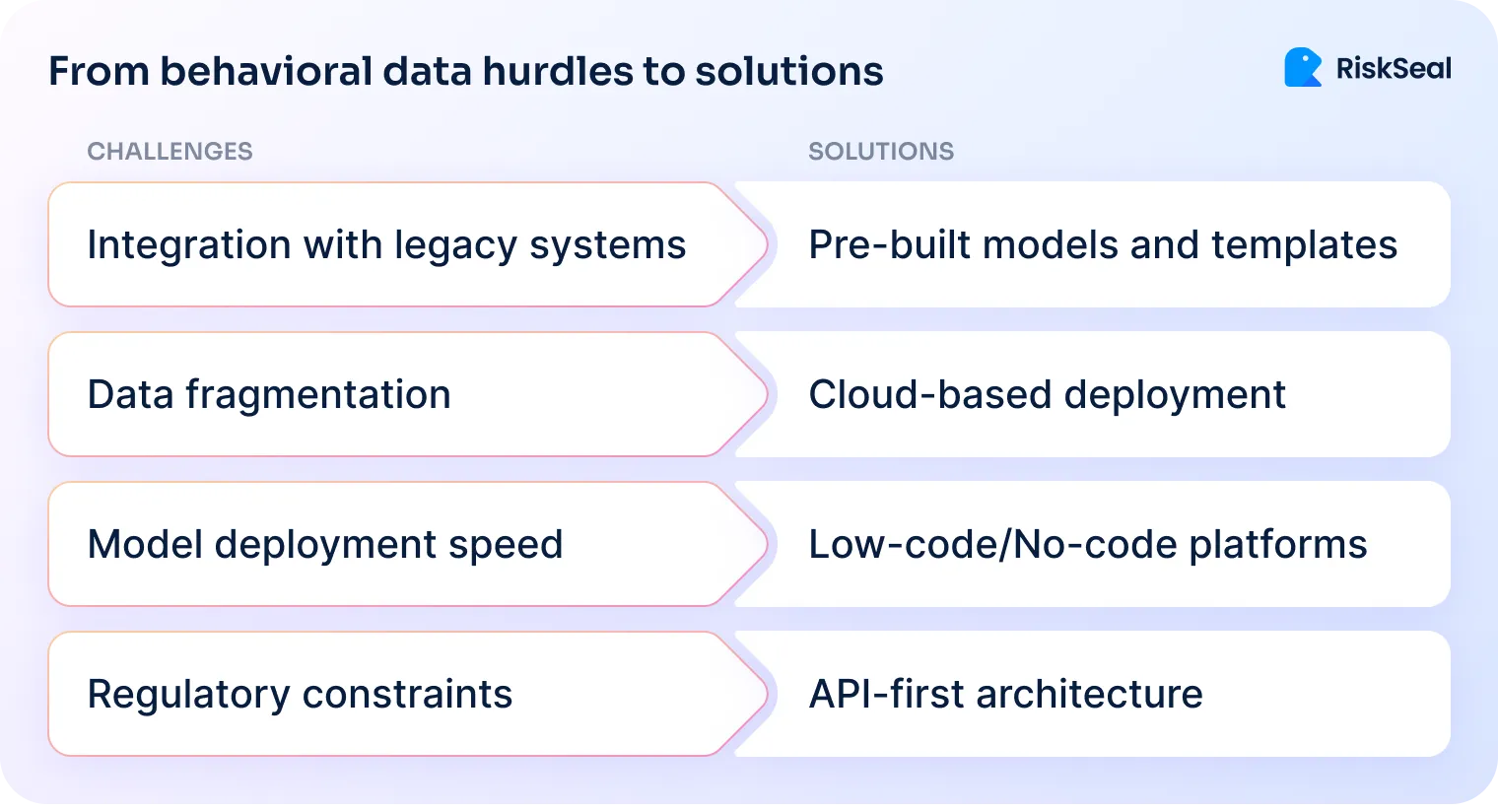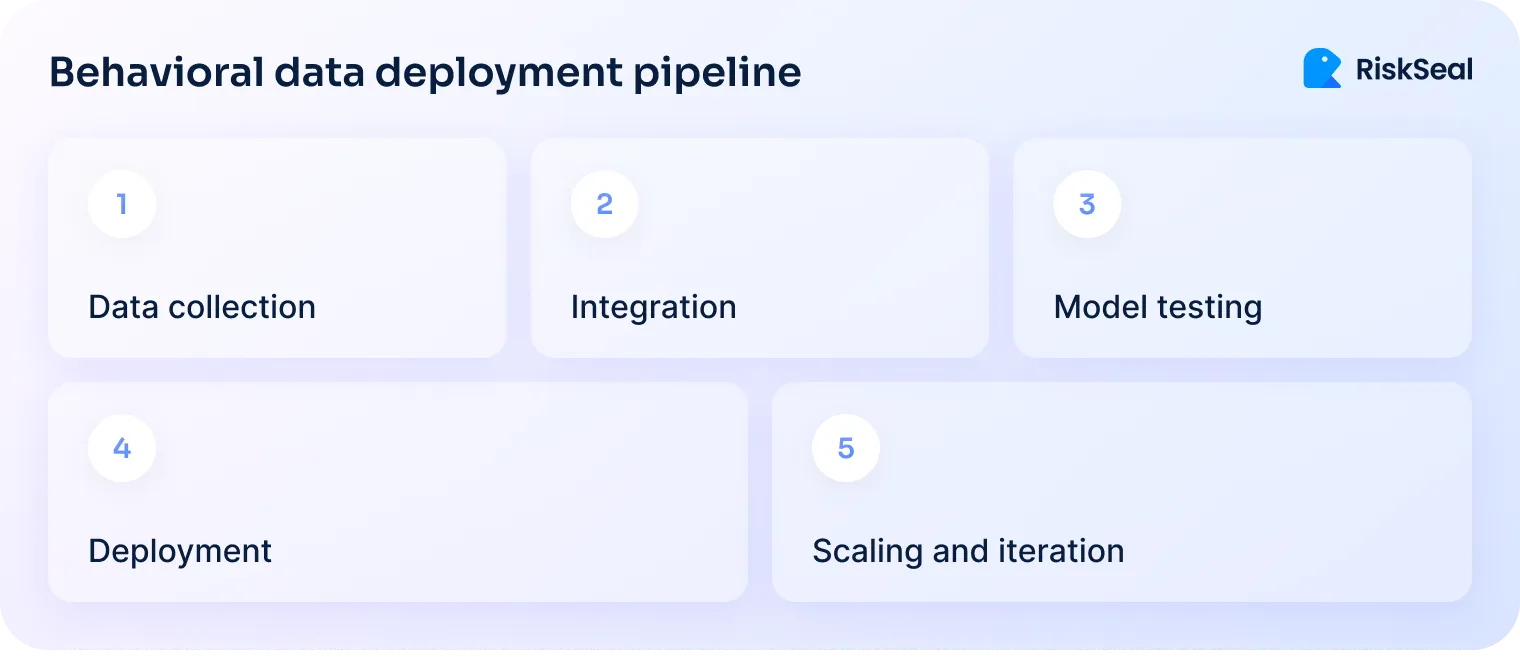Learn key behavioral data types, real-world use cases, and benefits for lenders.

Behavioral insights are becoming essential for credit risk assessment, driving demand for analytics solutions.
This demand is fueling behavior analytics market growth from $1.1 billion in 2024 to $10.8 billion by 2032.
In this article, we explore how behavioral data works in lending and the key patterns that help lenders assess real-world credit risk.
Modern credit decisions depend on more than just numbers from a credit bureau.
Behavioral data has become essential in understanding real-world risk. Especially in markets with thin files or first-time borrowers.

In lending, behavioral data means the digital and financial habits of applicants. These are shown through online activity, device use, and transactions.
These patterns help lenders look past basic checks to judge a borrower’s intent, consistency, and reliability.
Let’s look at three key categories that play a role.
Spending behavior is a window into a person’s priorities and financial habits.
Lenders can see how borrowers manage their money by reviewing bank transactions, digital wallet use, or open banking data.
Are they spending mostly on rent, groceries, and transportation? Or is there heavy discretionary spending on luxury goods or gambling apps?
Recurring payments are another powerful signal. Regular payments for utilities, phone plans, and streaming subscriptions suggest a disciplined approach.
These aren’t flashy metrics. But they reveal a borrower’s ability to stay on top of recurring responsibilities.
Income deposits round out the picture. A steady stream of income, even if from freelance or gig work, indicates financial predictability.
Paired with consistent cash flow, it builds trust in the borrower’s ability to manage repayment.
More advanced platforms apply Transaction Risk Analysis (TRA) on top of this data. This involves:
Used carefully, these patterns help lenders make decisions that are both faster and fairer.
The device a borrower uses during onboarding can reveal more than just their tech preference.
Mobile logins from the same device and location over time suggest consistent usage patterns.
In contrast, applying under multiple identities or from suspicious IPs can flag suspicious or bot activity.

Behavioral fingerprinting also plays a role. It analyzes technical markers, like operating system, screen resolution, or browser configuration.
This helps detect inconsistencies and unusual patterns.
Lenders often look for:
These signals create a digital context for each applicant. It’s useful for both fraud prevention and trust-building.
How a borrower communicates before and after applying can also signal reliability.
It’s not about reading messages or personal content. It’s about observing patterns of engagement and responsiveness.
Applicants who reply to emails quickly or open notifications often are more engaged. Those who ignore outreach entirely tend to be less responsive.
Customer support behavior also highlights how borrowers handle pressure or resolve issues.
Here are some common behavioral markers lenders use:
In context, these signals help tell apart genuinely delayed borrowers from those avoiding repayment. This distinction lets lenders respond with the right strategy.
Analyzing interactions and patterns allows lenders to spot both negative and positive signals.
Here are four common use cases.
For thin-file customers with limited credit history, traditional scoring may fall short. Transaction frequency and timely bill payments can act as reliable indicators of creditworthiness.
By using this data, lenders can expand credit access for underserved borrowers and tackle credit invisibility, showing in practice what is credit invisibility.
A drop in account log-ins or skipped repayment reminders can point to brewing financial stress. These changes may happen before a borrower misses a payment.
Lenders should act quickly to prevent defaults.
For example, by offering flexible repayment plans or early intervention.

Not all behavioral patterns suggest risk. Some highlight a borrower’s commitment to repay.
Regular small payments or frequent checks of repayment schedules show proactive engagement.
Lenders can use this data to reward borrowers with better terms or faster loan approvals.
Behavioral data can also help stop fraud before it causes losses.
A sudden shift in a borrower’s usual geolocation or device can trigger verification checks.
This quick response protects both the lender and the customer from unauthorized activity.
Using behavioral data in credit decisions brings clear benefits. But it also raises important ethical and regulatory responsibilities.
Lenders must handle this information in a way that protects customers and meets legal requirements.
Behavioral data often includes sensitive details about customer activity.
Lenders must store and process this data securely, following laws such as the GDPR and other regional rules.
A compliant approach usually involves:
These measures help maintain compliance and protect customer trust.
If left unchecked, behavioral data can reflect or amplify existing biases. This could lead to unfair treatment of certain groups.
Lenders should test their models regularly to detect bias and apply corrective measures.
The goal is to make credit decisions based on relevant, accurate factors. Not stereotypes or indirect discrimination.
Customers should understand how their behavior influences credit decisions. This means explaining, in plain language, which patterns are considered and why.
When people know what’s being measured, they can engage with the lending process more confidently.
At RiskSeal, ethical data handling is built into every process.
The company follows strict compliance frameworks and holds ISO/IEC 27001 Certification. This demonstrates its commitment to high standards in information security.
All RiskSeal’s workflows align with global privacy laws, including GDPR and LFPDPPP. Disaster recovery protocols are SLA-ready, enabling real-time recovery with an RTO of 1 hour and an RPO of 15 minutes.
In today’s lending, time-to-market is critical. Quick deployment of behavioral data directly influences customer acquisition and risk management.

Integrating behavioral analytics into lending processes can be complex.
Common obstacles include:
Integration with legacy systems
Many lenders still rely on core banking platforms that were never designed for behavioral analytics. Bridging these systems requires custom connectors and extra testing.
Data fragmentation
Behavioral signals often come from multiple channels: mobile apps, websites, and third-party platforms. Without unification, these insights remain siloed.
Model deployment speed
Slow transitions from data ingestion to model testing can delay innovation in credit decisioning. This puts lenders at risk of falling behind faster-moving competitors.
Regulatory constraints
Meeting data protection, auditability, and explainability requirements adds extra layers of approval before launch.
There are several proven ways to incorporate behavioral data into credit scorecards:
API-first architecture
Plug-and-play APIs allow lenders to collect, process, and score behavioral data. All without long development cycles.
This is also the integration method used by RiskSeal. It enables lenders to embed behavioral analytics into their existing workflows with minimal disruption.
Pre-built models and templates
Some vendors offer ready-to-use behavioral scorecards. These accelerate proof-of-concept stages and shorten the path to full production deployment.
Cloud-based deployment
Hosting behavioral analytics in the cloud allows instant scalability, reduced infrastructure costs, and continuous model updates.
This is especially valuable for lenders operating across multiple markets or product lines.
Low-code/no-code platforms
With low-code or no-code tools, non-technical teams can set up rules and scoring parameters. A/B tests can also be run without heavy engineering support.
This democratizes behavioral analytics and speeds up experimentation.
Adopting behavioral data analytics can improve loan performance and enhance customer experience.
The key is to follow a structured, test-and-learn approach that balances speed with compliance and trust.

Roll out behavioral analytics to a carefully chosen subset of loan products or customer segments.
This lets you measure results, refine models, and secure early buy-in without committing to a full deployment.
Key benefits of a pilot approach:
Many lenders begin with a proof-of-concept phase. It validates results and refines scoring strategies before scaling.
Flexibility is critical for future-proofing your lending platform.
Modular systems allow you to swap or upgrade components independently. An API-first approach ensures smooth, low-friction integration.
A sandbox allows teams to trial new data models and decisioning logic without touching live systems. This reduces operational risk.
Why sandboxes accelerate progress:
Specialized credit scoring software can bring ready-to-deploy infrastructure and deep compliance knowledge.
It helps shorten timelines and reduce complexity.
When choosing a partner, look for:
Borrower behavior changes over time, and your scoring models should too.
Continuous monitoring ensures accuracy and adaptability.
Ongoing optimization checklist:
The most effective lenders approach behavioral data adoption as an iterative process.
Starting small, scaling in stages, and making regular adjustments based on results.
A mid-sized online lender in Central Europe (the name is under an NDA) faced growing competition and tighter borrower assessment regulations. Thin-file applicants were especially hard to approve.
Relying on traditional scoring, the lender approved only about 10% of applications from thin-file clients.
Manual verification was slow, taking up to three days. High default risk in new customer segments made the team cautious, limiting growth.
The lender implemented behavioral data analytics through RiskSeal’s solution in a 30-day pilot.
Behavioral signals were integrated via an API-first connection into existing workflows.
It automated risk scoring and replaced most manual checks.
Approval rates in the thin-file segment rose from 10% to 19%.
Defaults fell by 18% in the first year. Decision time dropped from three days to three minutes.
Behavioral data allowed the lender to serve more customers, reduce risk, and stay competitive.
All without expanding its team.
Behavioral data gives lenders a deeper, more dynamic view of applicants.
It helps them make faster, fairer, and more profitable credit decisions. Especially when working with alternative credit data providers.
The key advantages include:
By turning everyday digital and financial behavior into actionable insights, lenders can improve both portfolio quality and customer relationships.
However, the effectiveness of behavioral data firmly depends on the alternative scoring provider of choice.
RiskSeal helps lenders turn behavioral data into clear, actionable risk signals.
By analyzing over 400 alternative data points, the platform identifies creditworthy borrowers early. It also detects potential risks and speeds up decision-making.

Key behavioral insights of our credit risk assessment software include:
Delivered via API, these insights greatly enrich scoring models.
RiskSeal’s data improves predictiveness (AUC 83%), cuts KYC costs by up to 70%, and reduces decision times to seconds.
The result: faster, fairer, and more precise credit approvals.

Download Your Free Resource
Get a practical, easy-to-use reference packed with insights you can apply right away.

Download Your Free Resource
Get a practical, easy-to-use reference packed with insights you can apply right away.




What are practical examples of behavioural data signals lenders can start using?

Lenders can track spending categories, such as essentials vs. luxury purchases. They can review payment consistency for bills and subscriptions.
Patterns in income deposits also reveal financial stability.
Digital footprint checks, like verifying if an email or phone is linked to trusted social profiles, can confirm applicant credibility.
How can lending institutions ensure ethical, compliant data usage?

Institutions should always obtain proper user consent. They must use data only for its stated purpose. Compliance with regulations like GDPR is essential.
Transparency matters, as it explains how decisions are made. Working with trusted vendors who follow industry standards reduces compliance risks.
How quickly can behavioural data solutions be deployed and scaled?

Modern platforms use API-first designs. This allows deployment in days or weeks.
Once live, they can handle higher volumes without major changes. Scaling to new regions or products is fast and efficient.
How does behavioural data enhance customer lifetime value and retention?

Behavioral insights help lenders offer relevant products and better repayment terms. This builds trust and drives repeat borrowing.
Lenders can also detect early signs of financial stress. Proactive support reduces defaults and keeps customers engaged.
Can behavioural data help launch or optimize BNPL and other innovative lending products?

Yes. It reveals short-term repayment capacity, even for thin-file customers. This enables safer BNPL offers.
It also helps refine eligibility rules and risk-based pricing. Better targeting improves adoption rates and repayment performance.